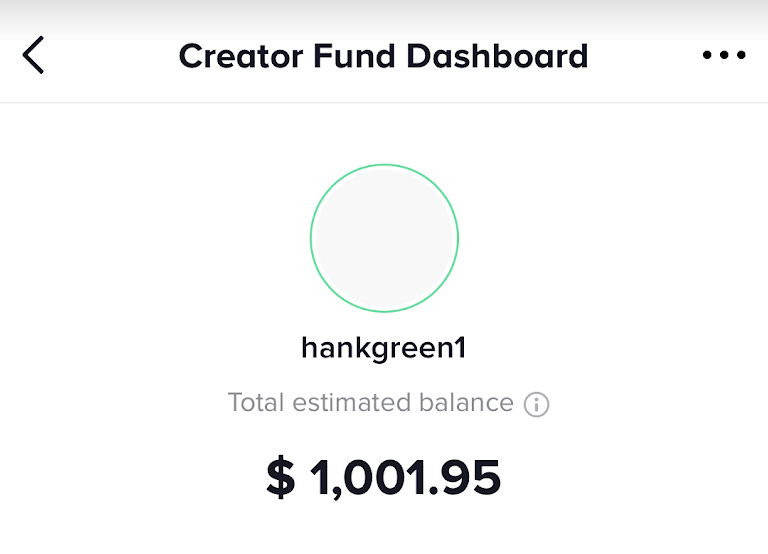

Discover more from Pay Attention
The Radical Egalitarianism of TikTok's Creator Fund Matters
How Platforms Divide up Earnings Among Creators Affects Who will Create and What Will be Created
YouTubers like myself take something as a given…the amount of money we make from YouTube is a function of the amount of money we make for YouTube. I have produced a lot of YouTube channels over the years, so I know that not every view is created equal.
The majority of YouTube ads are auctioned off to potential buyers, and those buyers are interested in reaching specific people. So if you make content about personal finance for affluent 30-somethings, there’s a lot more competition for your audience than if you’re making content for teenagers.
And on YouTube, you make 55% of whatever YouTube makes. There is something to be said for this transparency. It has a certain amount of fairness…but then, also, it has an amount of unfairness. People who get ten times more views, can end up making significantly less money. That’s not really fair to the creator, nor is it fair to the audience, who will be less served because advertisers are less interested in them.
This is not a new problem, of course. Magazines, movies, TV shows…you can make more (and spend more) if your audience has the money to pay — either for a subscription, or for a product that an advertiser is selling (or both.)
This matters, it affects what audiences get served and which creators can make a living. And, honestly, I haven’t even considered that there might be a different way.
Well, TikTok found a different way.

I just made my first $1000 through the TikTok creator fund. This fund budgets $200,000,000 per year to compensate TikTok creators not based on how much money they make the platform, but on how much “engagement” a creator’s content gets. My assumption is that the most important bit of “engagement” is the view, or possibly the amount of time spent viewing, though none of this is explicit.
But however it’s decided, the money is divided up equally among all accounts that receive this “engagement.” To explain how this works, let’s just imagine that the only metric that matters is the view: If the entire TikTok platform gets a billion views on any given day (it’s much higher than this, but just to make the numbers easy), and I’m responsible a million of them, then I will take home 0.1% of the fund’s daily allocation.
The money was in a big pot, and it’s getting spread around not based on who is responsible for making it, but by who is responsible for engagement.
There are some caveats here:
Engagement in certain regions / countries might not count, or count less.
There are probably some protections against fraud that decrease certain creator’s per-engagement revenue because there are (as on all platforms) lots of fake TikTok accounts.
But the end result is that, in my fishing around, everyone is making pretty much the same amount of money per view on any given day. There’s TONS of daily variation because there are a lot more views on TikTok on weekends than weekdays, and so the same number of views will be responsible for a smaller piece of the pie, but on any given day, it seems like everyone makes about the same amount of money per view, whether their audience is preteens or 40 year olds (and yes, there are olds on TikTok.)
On YouTube, this difference can easily be 10x or, in extreme cases 25x from creator to creator. TikTok’s model isn’t necessarily good or bad, but it is different in a way that matters.
It means that people with wealthy audiences don’t automatically make more than people with poorer audiences. And that might actually matter a lot. It’s not a shift that YouTube could ever make now, but it might end up actually being a better system for platforms that clearly care more about rewarding content that rewards viewers, rather than content that makes money.
Important Note #1: Just because this is how it is, doesn’t mean it’s what is intended.
TikTok may have done this because they believe (as is increasingly common) that attention is the one true currency, and it’s too narrow a view to imagine that just because one person has a more valuable audience means they are more valuable to the platform. But, honestly, it’s more likely that this is a function of how ads display on the platforms. On YouTube, an ad is tied to a piece of content, while on TikTok (as with Instagram) ads appear as independent pieces of content. That makes it hard (or impossible) to credit any individual creator with any individual ad impression. Likewise, the technology of figuring that out, even if you could…sounds complex.
Important Note #2: Just because these dollars are more egalitarian doesn’t mean the other ones are.
Brand deals, in-app gifts, merch, and crowd funding will be, as always, more lucrative for people who have audiences with more disposable income. But in this one way, there is a kind of egalitarian distribution of resources that really will impact which creators are able to make a living through their passion, and which audiences will be served when they otherwise would not have.
And, a message to any TikTok employees out there, the quantity and quality of content on your platform will only go up as the creator fund budget increases. Make it a fixed percent of your ad revenue, and make that percentage match or exceed YouTube’s, and see what kind of magic you inspire.
Subscribe to Pay Attention
Attention is becoming the one true currency, and that affects everything.







One must be careful when incentivizing content.
It's wild to me that this hasn't been done sooner and while I think this is a decent first step, the long term play is to give creators more overall stake in the platform since a platform's success is already a function of how invested content creators are. This could include a larger share of the profits but also extend to influencing the roadmap of the platform, the guidelines and moderation of the platform and many other concerns that are already top of mind for career minded creators.